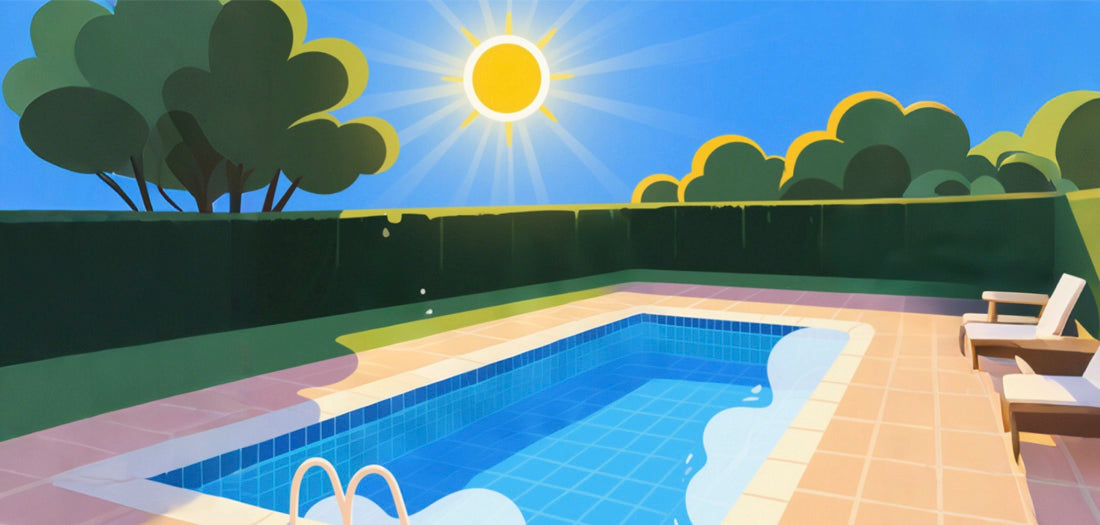
Essential Tips for Keeping Your Pool Clean and Safe in Extreme Heat
Share
As temperatures climb, your pool demands extra attention to stay crystal clear and chemically stable. Blazing sun and extended heat waves can accelerate water evaporation, trigger algae blooms, and throw chemical levels out of balance. But with a few smart strategies, you can keep your pool inviting and safe. Here’s how to beat the heat and maintain pristine water conditions.
1. Test Your Pool Water More Frequently
Under normal circumstances, checking your pool’s water chemistry once a week is enough. However, during extreme heat, chemical balances can shift unpredictably. To stay on top of changes, test your water at least two to three times per week.
Chlorine is particularly vulnerable to sunlight, depleting faster under direct exposure. Increased pool usage during heat waves can also disrupt water chemistry. By regularly monitoring your chemical levels, you can quickly make necessary adjustments and prevent issues before they arise.
2. Keep Chlorine Levels in Check
Hot temperatures create a breeding ground for algae, which depletes chlorine levels even faster. On top of that, UV rays break down chlorine, leading to an ongoing decline in sanitation effectiveness.
To ensure proper disinfection:
- Maintain free chlorine levels between 1 and 3 PPM, aiming for 3 PPM when temperatures are high.
- Stick to your normal chlorine schedule but add a weekly shock treatment to reinforce protection.
- If chlorine levels drop too low, use cal-hypo shock, liquid chlorine, or dichlor shock to replenish free chlorine and eliminate contaminants.
- If total chlorine remains high despite proper levels of free chlorine, a non-chlorine oxidizer can help break down spent chlorine.
- Saltwater pools may require occasional manual chlorine boosts to ease the burden on the salt chlorine generator in extreme heat.
If algae appears, double or triple-shock your pool to stop the problem before it spreads.
3. Use a Stabilizer to Protect Chlorine
Cyanuric Acid (CYA), often referred to as a stabilizer, helps prevent chlorine from rapidly degrading under UV rays. Without adequate stabilizer levels, chlorine dissipates quickly, requiring more frequent adjustments.
To maximize chlorine efficiency:
- Keep CYA levels between 30 and 50 PPM for traditional chlorine pools.
- If you use chlorine tablets or dichlor granules, they already contain CYA.
- If you use unstabilized chlorine like liquid chlorine or cal-hypo, add CYA separately to maintain effectiveness.
- Be cautious—excessive CYA can reduce chlorine’s effectiveness, and the only way to lower it is by partially draining and refilling the pool.
For saltwater pools, stabilizer levels should be slightly higher—between 60 and 80 PPM—to enhance chlorine retention in hot weather.
4. Stop Algae Before It Starts with Regular Cleaning
High temperatures create an ideal environment for algae to thrive. To keep your pool algae-free:
- Brush the walls and floor of your pool at least twice a week to prevent algae from settling.
- Vacuum regularly to remove debris and organic material that promote algae growth.
- If you own a robotic pool cleaner, run it more frequently during heat waves to maintain cleanliness with minimal effort.
Consistent cleaning prevents major outbreaks and minimizes the need for excessive chemical treatments.
5. Improve Circulation by Extending Pump Run Time
Good water circulation is key to preventing stagnant areas where algae and bacteria can flourish. A well-running pump ensures that chemicals are evenly distributed and debris is properly filtered.
- If you normally run your pump for 8 hours a day, increase it by 1–2 hours during intense heat.
- When temperatures exceed 100°F (37°C), consider running the pump for longer durations—up to 24 hours at a lower speed—to maintain water balance.
- If you have a variable-speed pump, running it at a low speed for extended periods can improve efficiency while keeping water moving.
A properly circulated pool stays cleaner and puts less strain on the filtration system.
6. Minimize Evaporation with a Solar Cover
Hot weather speeds up water evaporation, leading to fluctuations in water levels and chemical concentrations. On sweltering days, pools can lose up to ½ inch of water daily.
To reduce evaporation:
- Use a solar cover when the pool is not in use. It can cut water loss by up to 95% while keeping debris out and maintaining heat.
- Cover your pool at night when there’s a significant temperature drop, as this prevents excessive overnight evaporation.
However, before using a pool cover, ensure your water is properly treated. Sealing in unbalanced water can create an ideal environment for algae growth.
Stay Cool and Safe in the Sun
A clean pool is only part of the equation—staying safe under the sun is just as important. Provide shaded areas around your pool, apply sunscreen consistently, and keep water bottles within reach to stay hydrated. Heat exhaustion can sneak up quickly, so take breaks in cooler areas when necessary.
Final Thoughts
Maintaining a pristine pool during extreme heat doesn’t have to be a hassle. By testing your water frequently, stabilizing chlorine, preventing algae, improving circulation, and reducing evaporation, you can ensure your pool stays clean, balanced, and refreshing all summer long.
So, jump in, cool off, and enjoy a worry-free swim!
Looking for more pool maintenance tips? Explore our pool care guides to keep your swimming season hassle-free!
